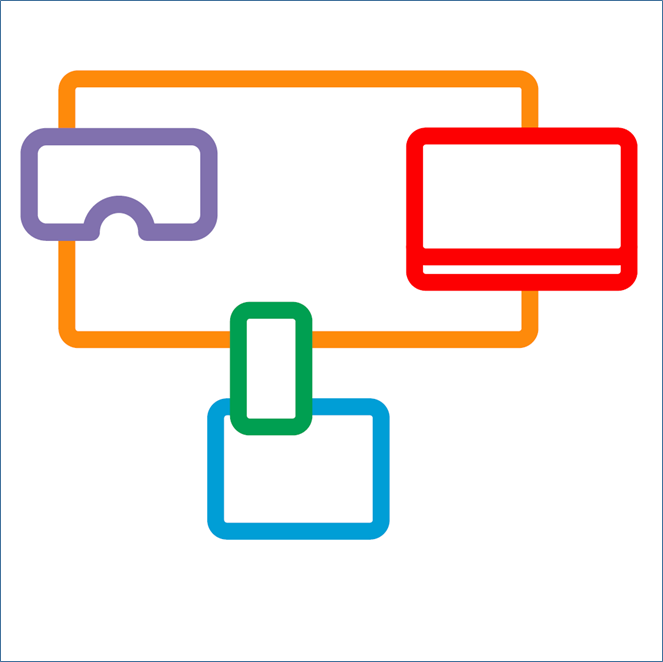Success for 2-Immerse at TVX
Jie Li honoured with Best Paper Award
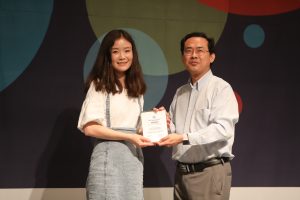 On 27 June Jie Li of the Distributed and Interactive Systems (DIS) group at 2-IMMERSE partner CWI was awarded with the Best Paper Award at ACM TVX 2018, the ACM International Conference on Interactive Experiences for Television and Online Video. Li won the award for the paper ‘A New Production Platform for Authoring Object-based Multiscreen TV Viewing Experiences’. Outlining research done within 2-IMMERSE, the paper has as co-authors Pablo Cesar, Maxine Glancy (BBC), Jack Jansen and Thomas Röggla
On 27 June Jie Li of the Distributed and Interactive Systems (DIS) group at 2-IMMERSE partner CWI was awarded with the Best Paper Award at ACM TVX 2018, the ACM International Conference on Interactive Experiences for Television and Online Video. Li won the award for the paper ‘A New Production Platform for Authoring Object-based Multiscreen TV Viewing Experiences’. Outlining research done within 2-IMMERSE, the paper has as co-authors Pablo Cesar, Maxine Glancy (BBC), Jack Jansen and Thomas Röggla
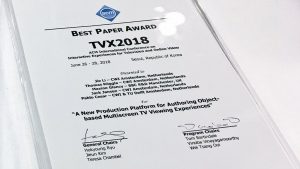
Multiscreen TV viewing refers to a spectrum of media productions that can be watched on TV screens and companion screens such as smartphones and tablets. TV production companies are now promoting an interactive and engaging way of viewing TV by offering tailored applications for TV programs.
However, viewers are demotivated to install dozens of applications and switch between them. This is one of the obstacles that hinder companion screen applications from reaching mass audiences. To solve this, TV production companies need a standard process for producing multiscreen content, allowing viewers to follow all kinds of programs in one single application. This paper proposes a new object-based production platform for authoring and broadcasting programs for multiscreen.
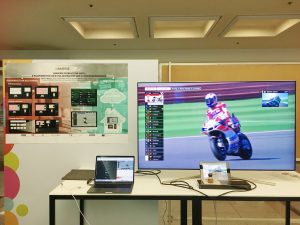 Besides the awarded paper, the DIS group also presented a demo at the conference, showcasing object-based live broadcasting of a sports event, to both a large TV screen and companion screens. The demo included both the producer and the user side. The producer side takes place inside an outside broadcast truck, where the director/producer can insert on-demand snippets and interactive components in the live broadcast. The user side is a home, where a viewer with a TV screen and several companion devices enjoy a personalized and interactive experience.
Besides the awarded paper, the DIS group also presented a demo at the conference, showcasing object-based live broadcasting of a sports event, to both a large TV screen and companion screens. The demo included both the producer and the user side. The producer side takes place inside an outside broadcast truck, where the director/producer can insert on-demand snippets and interactive components in the live broadcast. The user side is a home, where a viewer with a TV screen and several companion devices enjoy a personalized and interactive experience.
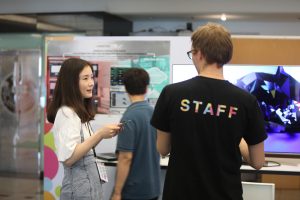
CWI’s Distributed and Interactive Systems (DIS) research group focuses on facilitating and improving the way people access media and communicate with others and with the environment. They address key problems for society and science, resulting from the dense connectivity of content, people, and devices. The group uses recognized scientific methods, following a full-stack, experimental, and human-centered approach.
More at TVX from BBC and IRT
A work-in-progress paper submitted by BBC and IRT explores the potential of augmented reality technology as a novel way to allow users to view a sign language interpreter through an optical head-mounted display while watching a TV programme. We address the potential of augmented reality for personalisation of TV access services. Based on guidelines of regulatory authorities and research on traditional sign language services on TV, as well as feedback from experts, we justify two design proposals. We describe how we produced the content for the AR prototype applications and what we have learned during the process. Finally, we develop questions for our upcoming user studies.
Also at TVX BBC and IRT demonstrated results of our work stream which targets deploying the 2-IMMERSE apps on HbbTV 2.0 devices. In cooperation with Samsung we showed the 2-IMMERSE MotoGP experience from Silverstone GP 2017 on a recent consumer device running an HbbTV 2.0 ready firmware.
READ MOREMotoGP roars out on a HbbTV 2 television
MICHAEL PROBST from the 2-IMMERSE partner IRT introduces an impressive video showcasing our MotoGP prototype running on a HbbTV 2 television.
The 2-IMMERSE architecture has been built around the HbbTV 2 specification, mainly using the new protocols defined for interaction and media synchronisation with multiple screens in the home network.
During the services trials, the project has made use of custom prototype units as client devices. For the most recent trials a Intel NUC-based Linux PC was used to emulate the main TV and feed the screen in the home.
In a parallel track, however, the 2-IMMERSE implementation of the MotoGP trial has been tested and validated with televisions supporting HbbTV2 that became available in 2018. Watch the video, hosted by IRT’s Florian Bachmann, to see the MotoGP showcase on one of the first HbbTV 2 televisions and learn more about which features 2-IMMERSE actually uses from HbbTV 2.
You can see this demonstration at IFA in Berlin (31 August – 5 September) and IBC2018 in Amsterdam (14-18 September) at the IRT stands (hall 2.2@IFA, 10F51@IBC) in addition to the 2-IMMERSE main presentation in the IBC Future Zone.
READ MOREIt’s trial time!
DOUG WILLIAMS from BT writes: Will the system work? We are in the final throes of preparing for the MotoGP at Home trial, as the boxed up “kits” above demonstrate. Anyone who has been in that state will be familiar with the uneasy mix of excitement and uncertainty.
For the MotoGP at home tests we are seeking an evaluation, from MotoGP fans, of our ‘as-live’ multi-screen production of this year’s Silverstone race. We are conducting nearly all the trials in people’s homes and our ambition is that the system is robust enough and simple enough for our triallists to use with minimal instruction; we are seeking 100 responses.
At the moment the experience depends on support for elements of the HbbTV2.0 specification and some other capabilities that cannot be reliably found on any common TV platform. So we are having to provide a small computer together with a phone and tablet as the apps we are using are not available on any app store. That’s what you can see in front of the boxes.
There is a lot of last minute logistics and bug-fixing going on and Murphy’s law is in full operation. To help on the logistics side – needing to find 50 duo households of people who are already keen on MotoGP – we have enlisted the help of a recruiting agency, Acumen, who will tomorrow receive seven test kits and some training from us and who will then go away and start conducting tests with screened triallists who already watch MotoGP.
Fundamentally we want to know whether the experience we create feels like an enhancement to the excellent coverage already available. We want the evaluation to uncover more about the utility, and perhaps futility, of certain features, and so help us to retain good ideas and drop bad ones. And we intend too that it will help us highlight the strengths and weaknesses of the technical platform on which it is all built.
We trust our triallists enjoy their experience — and of course we hope the system works!
READ MORE
